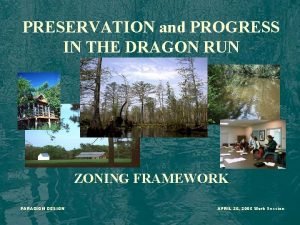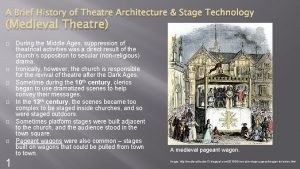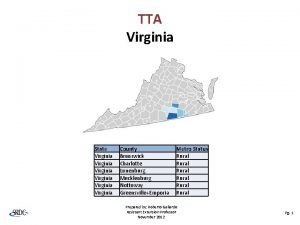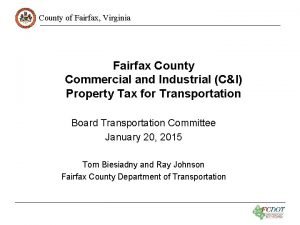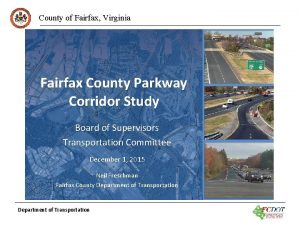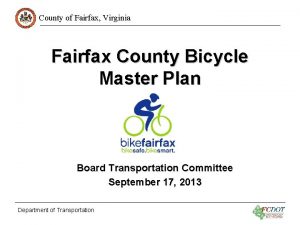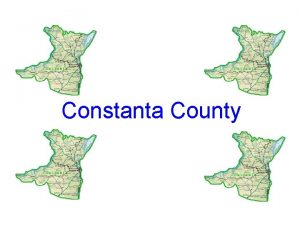History and Architecture in Southampton County Virginia Southampton
































- Slides: 32

History and Architecture in Southampton County, Virginia Southampton County P. O. Box 400 Courtland VA 23837 Virginia Department of Historic Resources 2801 Kensington Avenue Richmond VA 23221

Southampton County • • • Located along the Virginia/North Carolina border Centered around the Blackwater and Nottoway Rivers County is a mostly rural area. Principal towns: Courtland Boykins Smaller towns/communities: Ivor, Newsoms, Capron, Sedley, and Sebrell • Agriculture and forestry principal industries • Modern development around City of Franklin

Map of Southampton 1895

Native Americans to 1607 • Human occupation of the land extends more than ten thousand years ago • The Nottoway and Meherrin Indians occupied the land • European settlers forced Indians onto reservations near Courtland • Period marked by warfare and open hostility between natives and Europeans • No above-ground physical remains from this early period

John Smith Map 1612

European Settlement to Society 1607 -1750 • Exploration of the colonies and rapid expansion westward • Cultivation of tobacco and food crops, desire for new plantations/farmsteads over settled towns • Deterioration of relations between colonists and Native Americans-Indian uprisings • 1749 Southampton County was formed

Architecture 1607 -1750 • Few buildings constructed prior to 1750 in Southampton survive • Early architecture copied traditional or vernacular patterns brought from Europe • Small farmstead dwellings-modest rectangular one or two room house plans, with a loft. • Plantation houses-English Colonial and Georgian style--do not represent average dwelling in Southampton • Introduction of hallways and central passage/side passage plans or I-houses allow for privacy and designation of single purpose rooms

Clements 087 -0011 Riverview Farm 087 -5379 Beechwood 087 -0002

Colony to Nation 1750 -1789 • First permanent court built in Courtland, 1752. • Construction of roads, bridges, ferries and taverns. • Farmers engaged in grain farming and raising cattle and hogs. Tobacco still remained an important cash crop. • 1775 --Revolutionary War. Southampton was affected minimally as opposed to Tidewater region. • After the war, residents continued to develop the agricultural and forest economy of the county.

Architecture 1750 -1789 • Large colonial houses often constructed in variations of the dominant Georgian style (simple one or two story box, two rooms deep, varied roof lines, cornice with decorative molding, doors and windows in strict symmetry). • One-story shed extensions typically added on the rear to provide more space as needed. • Full-width, shed-roofed front porches became universal. • Service functions, like kitchens were separate buildings located near the main house as dependencies.

Rotherwood 087 -0045 Simmons-Sebrell Camp House 087 -5377 Rebecca Vaughn House 201 -5002

Catslide House 087 -0106 John Whitfield House 087 -5270

Early National Period 1789 -1830 • Basis for economy: grain, some tobacco, fruits, hogs, cotton, and timber. • White and slave population increased; opposite of Tidewater region. • Slavery debate: gradual emancipation, repatriation, and slave revolts. • Southampton landscape--land owned by mid-level farmers and planters.

Architecture 1789 -1830 • Development of house patterns and styles; new ideas about formality, proposition, style and classical themes emerge (i. e. Greek Revival, Colonial, Classical and Colonial Revival). • Slaves and poor whites lived in small frame houses-most were dependencies on larger plantations. • Number of middle income housing from this period-smaller homes which have been expanded upon.

Mahone Tavern 201 -5001 Hart’s Tavern 201 -5003 Rochelle Prince House 201 -5002

Aspen Lawn 087 -0137 William Drewry House 087 -5036 Emma Jackson House 087 -5517

Antebellum Period/Civil War 1830 -1865 • Population split evenly between whites and African Americans. • Agriculture principal occupation of land holding population: diversified farming and crop rotation. • Nat Turner 1831 Slave Rebellion-strict laws restricting the rights of African Americans. • One of the earliest railroads established in 1834 with the Portsmouth and Roanoke line. • Civil War-1861 -1865. Southampton was part of the Confederate lifeline.

Architecture 1830 -1865 • Domestic architecture reflected economic status of the landowner. • Smaller hall and parlor type houses were utilized from earlier periods often with later, two story additions. • Greek Revival popular with the more affluent. Have large entry porches with prominent square posts or round columns with capitals. • Early Classical Revival-builds upon the Georgian and Federal styles with an entry porch or portico that dominates the front façade and supported by four classic columns.

Benjamin Pope 087 -5419 Berlin School 087 -5339 Pope Family Farm 087 -5417

Gus’ Corner 087 -5518 Richard Porter House 087 -0083 Peter Edwards House 087 -5440

Reconstruction 1865 -1880 • Time of stability and progress-loss of free agricultural labor. • 1872 first comprehensive school system. • Peanut industry flourished-Pretlow Peanut Company was first peanut checking plant. • Railroad continued to be a significant economic factor in the county.

Architecture 1865 -1880 • Number of Victorian architectural styles were popular. • Second Empire style found in cities and towns. • Gothic Revival style houses had steeply pitched roof with decorative gable verge boards. • Italianate style buildings had a low-pitched hipped roof with overhanging eaves decorated with brackets, sometimes a cupola or tower.

Simmons Home Farm 087 -5378 Sunnyside 087 -0117

Growth 1880 -1900 • Growth of towns and commerce in the area-result of construction of the Atlantic and Danville Railroad 1888. • Peanut production nearly doubled. • Second largest growing industry-lumber.

Architecture 1880 -1900 • Style most often observed is vernacular Victorian, adapted into existing traditional building styles such as the I-house. • Victorian Queen Anne style appeared-steeply pitched roofs with irregular shapes, dominant front-facing gable, patterned shingles, bay windows, and decorative turned spindles. • Richardsonian Romanesque-popular in cities and larger towns-hipped roofs, round towers with conical roofs, rounded arches over windows, and constructed of stone and/or rough masonry.

Captain Pretlow House 087 -5448 Feltz House 174 -5002 -0023

Modern Southampton 1900 -1950 • Four Railroad lines were servicing the county. • New communities and towns developed along the railroad lines. • Agriculture was primary economic activity. • Major industries: peanuts, lumbar and paper manufacturing, and concrete and pallet companies.

Architecture 1900 -1950 • “Four Square” house-usually with hipped or pyramidal roofs. • Colonial Revival style • Bungalows/Craftsman style homes-low pitched roofs, sideor-front gabled, exposed rafters, tapered porch piers. • Modern housing after 1935 - ranch houses, split levels, and contemporary style homes.

22160 Main Street 201 -5001 -0020 Wakefield School 087 -5411 Joyner Store 087 -5513

Survey and Documentation Priorities • Continue to survey and document historic properties within county limits. • Develop comprehensive cultural resources management plan that integrates archeology, the built environment, historic landscapes, and other cultural/historical elements. • Evaluate and nominate properties and districts for listing in the National Register of Historic Places. • Integrate other cultural resource studies into planning efforts, including archeological investigations, oral histories.

Preservation Planning Priorities • Office of Planning should consider effects to historic resources in reviewing subdivision applications. • Historic resources GIS layers should be periodically updated. • Promote adaptive re-use of historic buildings. • Promote the use and applicability of state and federal tax credits for rehabilitation of significant historic properties. • Integrate historic preservation plan with city or county comprehensive planning. • Evaluate feasibility and public support of historic preservation ordinances.

Acknowledgments This project was funded through the Virginia Department of Historic Resources (VDHR) Cost Share Program. This presentation was prepared by The Ottery Group, Inc. under contract number with the VDHR, for Southampton County and the VDHR.
 Southampton county, virginia plantations
Southampton county, virginia plantations Southampton county social services
Southampton county social services Northern virginia seo audit
Northern virginia seo audit Middlesex county virginia
Middlesex county virginia Pgr tracker southampton
Pgr tracker southampton Eprints southampton
Eprints southampton Southampton city council homeless
Southampton city council homeless Southampton township school district
Southampton township school district Population of southampton 2021
Population of southampton 2021 University of southampton enabling services
University of southampton enabling services Sussed soton login
Sussed soton login Vevox.com login
Vevox.com login Southampton district energy scheme
Southampton district energy scheme Matt ryan southampton
Matt ryan southampton Dimensions southampton
Dimensions southampton Gary wills southampton
Gary wills southampton Southampton actuarial science
Southampton actuarial science Nick evans southampton
Nick evans southampton Will baker southampton
Will baker southampton Southampton education school
Southampton education school Eprints southampton
Eprints southampton Agresso southampton
Agresso southampton Southampton city council procurement
Southampton city council procurement Quitters southampton
Quitters southampton Pgrtracker
Pgrtracker Agresso southampton
Agresso southampton Call and return architecture in software engineering
Call and return architecture in software engineering Escambia biology
Escambia biology Software architecture business cycle
Software architecture business cycle Integral product architecture example
Integral product architecture example Types of modular architecture
Types of modular architecture 3 bus architecture
3 bus architecture History of theatre architecture
History of theatre architecture



